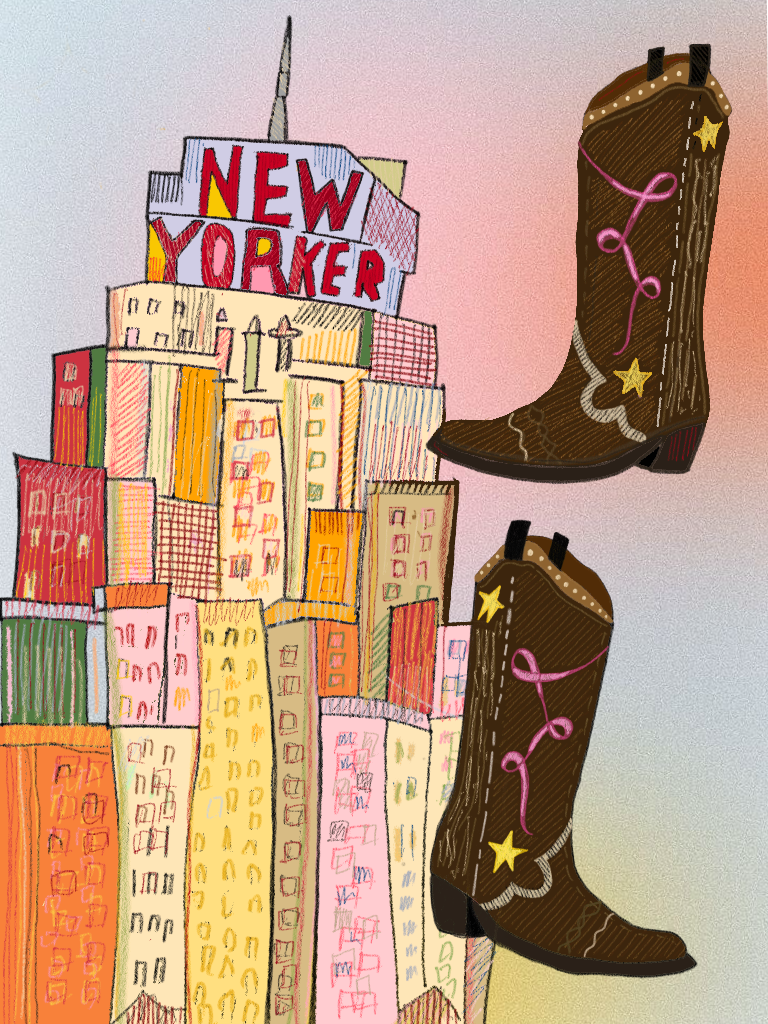Cowboys in the Concrete Jungle
By Bryn Palmer
April 18, 2024

Graphic by Emmy Chen
In Texas, fashion starts in March.
Contrary to the luxurious and haute couture fashions of the European nature, the Lone Star State’s runway comes in the form of a dust-lined arena reeking of cow manure with faint notes of smoky barbecue and buttery fragrances fluttering in the air. Its models valiantly board bucking bulls, wrangle with unaccommodating steers, and swiftly swerve between barrels on horseback. Attendees watch in awe while gluttonously devouring a diabetes-inducing assortment of succulent meats and deep-fried delicacies.
Models adorn their bodies in figure-hugging denim held up by leather belts embellished with turquoise and rustic metals. Soft, wool brimmed hats enhance their braided tresses. Paisley-printed bandanas adorn their necks while preventing gusts of sand from polluting their airways. But of course, their outfits lack without the perfect pair to cover their feet.
Meticulously crafted from artisanal leather, precisely stitched with expression and perfectly polished, cowboy boots expand in character and originality with each wear. They enable the wearer’s performance during the boisterous events of the annual rodeo. Texas ceases to exist without these shoes.
Wearing cowboy boots is a rite of passage for many Texans. I still remember my first pair. Styled with my bubble gum pink hat and Astros baseball bat, my scarlet red boots revealed my native Texan and Houstonian identities. I still have all three, safeguarded with other tokens from my youth. I accumulated more of these shoes throughout my childhood, needing them for the signature Go Texan Day, when school boards encouraged students and teachers to dress like cowboys and girls to kickoff the Houston Livestock Show and Rodeo, but none carry the same nostalgia as that initial pair.
Given the depth with which we embed these shoes in the state’s culture, it came as a huge surprise when I embarked on the 1,628 mile airbound journey from Houston to New York City and found these same boots.
I watched them walk down Fifth Avenue, on the feet of Upper East siders going on their daily matcha runs. They escaped to Central Park when their user needed fresh air and serenity. I even stalked the bluebonnet state’s signature shoe on the subway, as its wearer ventured from way uptown in Harlem and across the Brooklyn Bridge to Dumbo.
Alicia Keys’ so-called City of Gods already stripped the former republic of its fashion greats like Tom Ford and Brandon Maxwell. Now it sets its eyes on the relished craft of bootmaking, Texas’ reigning artform for centuries. But, why?
In the ‘50s, the silver screen transported viewers to the Old West. Metamorphosing into the vengeful Ethan Edwards in “The Searchers,” the grim-faced actor John Wayne adjusted to life on the prairie well. Turbulent plot aside, the object of the metropolitan viewer’s desire guarded the lead man’s feet.
Characterized by deep creases and dirt accumulated throughout Wayne’s perilous crusade through the desert, his Roper boots came embellished with gleaming silver spurs. City goers weren't exactly embarking on quests to find their kidnapped nieces while avenging the gruesome deaths of their family members, but for them, these shoes opened the door to that lifestyle.
But, urbanites wouldn’t dare sacrifice fashion.
Daily tasks of gracefully gliding through fields atop horses, keenly escorting herds of cattle across mass acres of land, and perceptively swinging ropes to catch calves require the anatomy of Texan-bred boots to differ from their eastern counterparts. In the Big Apple, these boots were solely made for walking. During the Civil War of cowboy boots, the former confederate state favors a rounded toe and higher heel to accommodate the swollen, calloused feet of its wearers. The Union, in their appropriation, eradicates the need for functionality with its extension of the toe to a point and shrinking of the heel.
The concrete jungle is not alone in its pursuit of embodying the Wild West.
Oui, oui. L’imitation est la meilleure forme de flatterie.
Aside from Pharrell’s high fashion fusion of Black America’s fly, exuberant streetwear and the Western frontier’s stitched leathers, draping fringe and statement bolo ties, Paris boasts its own assortment of independent boot retailers. Possessed by his agrarian alter ego called John West, Jean Guillemette introduced French markets to cowboy boots when he opened his GOWEST store in 1974. Resembling something of a Cavender’s, the storefront sits amid a stretch of grassland and fittingly comes decorated with serape-lined tables, wooden fixtures, and barrels. Extra Americana flare comes from the subtle hints of red, white, and blue sprinkled throughout the sales floor. In crafting the pairs with beveled heels, coating them in hides imported from Mexico, and blessing them with Parisian flair, he manufactured the French cowboy, who didn’t transform, but was simply “born with a pair of GO West on [his] feet.”
Though they may endure cosmetic changes as the terrain differs, cowboy boots indicate how fresh creations stem from the international diffusion of ideas. As cultural exchanges occur, beauties meet the eyes of new beholders, leading fragments of one designer’s work to inspire the birth of another’s. As travelers come and go, experiencing a snippet of life in the state where everything’s bigger, they feel compelled to form their own adaptations of Texan fashions.
But from one Texan girl to a New Yorker, “if it ain’t broke, then don’t fix it.” ■
Other Stories in Fashion
© 2024 SPARK. All Rights Reserved.
